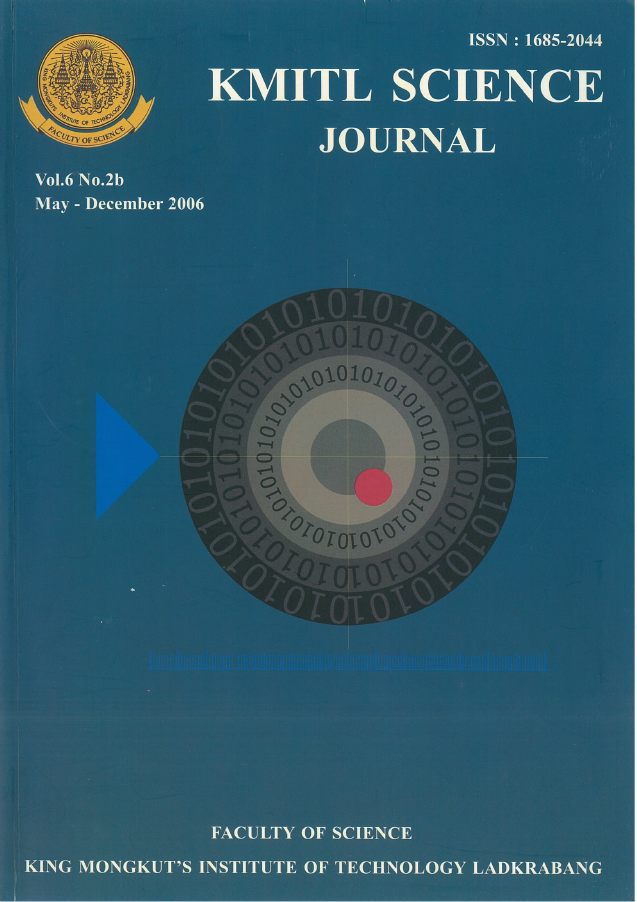0.86 MHz and 3 MHz Continuous Ultrasound Exposures on Alterations of Median Nerve Properties
Main Article Content
Abstract
Ultrasound has been extensively used for a variety of treatments. Some researches have shown that it has ability to stimulate the nerve action potential but there have been in vivo no comparison of nerve property alterations between the 0.86 MHz and 3 MHz ultrasound treatments. Consequently, the purpose of this study is to study the effects of ultrasound at various intensities and frequencies on electrical properties of the median nerve. Twenty subjects were randomly selected for 0.86 MHz and 3 MHz ultrasound exposures. The median nerve electrical properties after 10 minutes of both 0.86 MHz and 3 MHz ultrasound exposures at four intensity levels i.e. 0.5, 1.0, 1.5 and 2.0 W/cm2 were compared with pre-exposure. No significant differences were noted between pre-exposure and immediately post-exposure at all intensity levels of 3 MHz. For 0.86 MHz, median nerve conduction velocity after ultrasound exposure increases approximately 4.5% and 2.7% at 1.5 and 2.0 W/cm2, respectively. The results show that the 10 minute exposure of 0.86 MHz ultrasound at 1.5 W/cm2 plays a significant role in affecting the nerve conduction velocity. Although in this study, the nerve conduction velocity increases correspondingly with skin temperature decreases whereas other studies reported that an increase of intramuscular temperature was found. In conclusion, clinicians or physical therapists can take benefits of this result for a guide to select the suitable frequency, intensity and exposure time when using ultrasound therapy for nerve rehabilitation.
Keywords: Median Nerve, Ultrasound Intensity, Ultrasound Frequency, Skin Temperature, Amplitude, Conduction Velocity
Corresponding author: E-mail: VAA@kmitnb.ac.th
Article Details
Copyright Transfer Statement
The copyright of this article is transferred to Current Applied Science and Technology journal with effect if and when the article is accepted for publication. The copyright transfer covers the exclusive right to reproduce and distribute the article, including reprints, translations, photographic reproductions, electronic form (offline, online) or any other reproductions of similar nature.
The author warrants that this contribution is original and that he/she has full power to make this grant. The author signs for and accepts responsibility for releasing this material on behalf of any and all co-authors.
Here is the link for download: Copyright transfer form.pdf
References
[2] Dysen, M. and Suckling, J. 1978 Stimulation of Tissue Repair by Ultrasound: A Survey of the Mechanisms Involved. Physiotherapy, 64, 105-108.
[3] Hayes, K. 1992 The Use of Ultrasound to Decrease Pain and Improve Mobility. Critical Review of Physical Medicine of Rehabilitation Medicine.3, 271-287.
[4] Klaiman, MD., Sharader, JS., Hicks, JE. and Danoff, JV. 1995 Phonophoresis Compared to Ultrasound in the Treatment of Chronic Musculoskeletal Conditions[abstract]. Medical Science and Sport exercise, 27, S51.
[5] Dyson, M. 1987 Mechanisms Involved in Therapeutic Ultrasound. Physiotherapy, 73, 116-120.
[6] Lehmann, JF. and Delateur, BJ. 1982 Krusen’s Handbook of Physical Medicine and Rehabilitation 3rd ed. WB Saunders, Philadelphia, PA.
[7] Hadjiargyrou, M., Mcleod, K., Ryaby, J. and Rubin. 1998 Enhancement of Fracture Healing by Low Intense Ultrasound. Clinical Orthopedics, 355, 216-229.
[8] Blinc, A., Francis, C., Trudnowski, J. and Carter, E. 1993 Characterization of Ultrasound-Potentiated Fibrolysis in Vitro.Blood.81, 2636-2643.
[9] Dyson, M. and Pond, JB. 1970 The Effect of Pulse Ultrasound on Tissue Generation. Physiotherapy. 64: 105-108.
[10] Kramer, JF. 1984 Ultrasound : Evaluation of Its Mechanism and Thermal Effects. Archives of Physical Medicine and Rehabilitation. 65, 223:227.
[11] Patrick, P. 1978 Applications of Therapeutic Pulsed Ultrasound. Physiotherapy. 64(4), 103-104.
[12] Byl, NN., Mckenzie, A., Wong, T., West., J. and Hunt, TK. 1993 Incisional Study of Low and High Dose Ultrasound. Journal Orthopedic and Sports Physical Therapy.18(5), 619-628.
[13] Oakley, EM. 1978 Application of Continuous. Physiotherapy. 64(6), 169-172.
[14] David, O., Draper, J., Chris, C. and Dawn., C. 1995 Rate of Temperature Increase in Human Muscle During 1 MHz and 3 MHz Continuous. Journal Orthopedic and Sports Physical therapy 22(4), 142-150.
[15] Currier., DP., Greathouse. and Swift, T. 1978 Sensory Nerve Conduction : Effect of Ultrasound. Archives of Physical Medicine and Rehabilitation. 59, 181-185.
[16] Parley, W., Madson. and Jerome, G. 1961 The effect of ultrasound on conduction velocity of periphyeral nerve. Archives of Physical Medicine and Rehabilitation.9 : 645-649.
[17] Gann, N. 1991 Ultrasound : current concepts. Clinical Management. 11(4), 64-69.
[18] Forst, G. and Rosen., C. 1989 Ultrasound Effectiveness of Treatment Given Under Water. Archives of Physical Medicine and Rehabilitation. 70, 28-29.
[19] Coakley, W. T. 1978 Biophysical Effects of Ultrasound at Therapeutic Intensities. Physical Therapy. 64(6), 166-169:
[20] Williams, R. 1987 Production and Transmittion of Ultrasound. Physical Therapy.73 (3), 113-116.
[21] Dyson, M. 1987 Mechanism Involved in Therapeutic Ultrasound. Physical Therapy. 73, 116-120.
[22] La Van, F.B. and Hunt, TK. 1990 Oxygen and Wound Healing. Clinics in Plastic Surgery. 17, 463-472.
[23] Blickford, RH. and Duff, RS. 1953 Influence of Ultrasonic Radiation Temperature and Blood Flow in Human Skeletal Muscle. Circulation Research. 1, 534-538.
[24] Wayne, C., Farmer. 1968 Effect of Intensity of Ultrasound on Conduction of Motor Axons. Physical Therapy. 48(11), 1233-1237.
[25] John,H., Charles, S. and David, G. 1981 Ultrasound’s Effect on the Conduction Latency of the Superficial Radial Nerve in Man. Physical Therapy. 61(3), 345-350.
[26] Zankel, HT. 1966 Effect of Physical Agent on Motor Conduction Velocity of Ulnar Nerve. Arch Phys Med Rehabil. 47, 787-792.
[27] Margaret, M., Portwood, J., Liberman, S., Robert, G. and Taylor. 1987 Ultrasound Treatment of Reflex Sympathetic Dystrophy. Archives of Physical Medicine and Rehabilitation. 68, 116-118.
[28] Colak, T., Bamoc, B., Ozbek, A. Budak, F and Bamac, YS. 2004 Nerve Conduction Studies of Upper Extremities in Tennis Players. British Journal of Sports Medicine. 38, 632-635.


